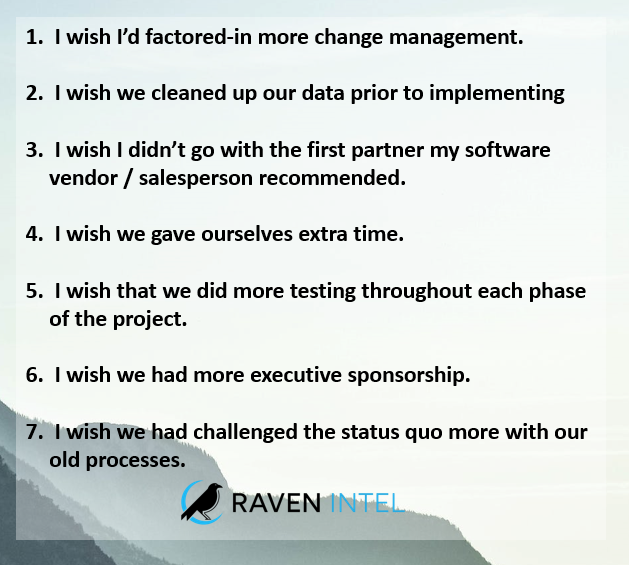 1. I wish we’d factored-in more change management.
1. I wish we’d factored-in more change management.
Change is never easy, so investing enough time and money to ensure that the right communication, training and documentation happens throughout the project will benefit you in the end.
> “The “change management” aspect is far more difficult and takes more time {than you’d think it would be}. Communicate heavily from the from the beginning and engage, engage, engage people … from 10 at the start we engaged actively over 150 closer to launch time. Your HR process owners needs to be clear about their process, have those discussion prior implementation or allocate time in your project if it was not done.” (SAP SuccessFactors)
> “You get what you pay for–spend the money to have the consultants train your internal staff before the implementation is complete. A brief “knowledge transfer” after all configuration work is done is not enough to adequately support the system.” (Oracle HCM Cloud)
> “Change management–really thinking through key factors such as time investment, speed, accuracy, and simplification of processes into the system are areas that needs more focus prior to implementation.” (Workday)
> “Functional consultants should be on-site for knowledge transfer and to ensure they were focused on our project and not others.” (Oracle HCM Cloud)
2. I wish we cleaned up our data prior to implementing {the new system.}
There’s a reason you’re changing systems, and it’s easy to think that a new user interface will make it easier to clean up old information. Not so. Take the extra time before you start to ensure your data comes over clean. (You’ll have more important things to worry about.)
> “We should have spent more time correcting our current state prior to our project launch. Fixing the current and preparing for the future has been a difficult task.” (Workday)
> “Make sure you’ve taken the time to clean up all your legacy data so you are not bringing bad data in to your new system.” (SAP SuccessFactors)
> “Give yourself extra time for implementation. Vendors will say they can implement in a set amount of time – double it or triple it. Also, clean up your historical data – scrub, scrub, scrub – before you upload. (Ultimate Software)
3. I wish we didn’t go with the first partner my software vendor / salesperson recommended.
Making a decision about the software you choose usually takes center stage, but a successful project will hinge on the quality of the partner and resources you hire to help you implement. Don’t shortchange yourself by not independently vetting partners & doing your own homework in selection. In addition, make sure you read and understand the Statement of Work presented by your consulting firm. It goes without saying, multiple change orders mid-project will have a negative impact on your project and satisfaction. (Raven Intel can be a solid resource to help you craft your shortlist & find independent peer references that speak to the quality & merit of a firm’s work.)
> “Regardless of the size of your firm, request that you have a solutions design consultant as part of the SOW build out, as the sales team representing our size firms was not well equipped to appropriately build and execute the SOW for our company. The SOW discussions took as long as the entire implementation project, and the process was remarkably improved once we escalated from the Sales team to other connections in the company.” (Workday)
> “Check out a partner’s technical expertise thoroughly – not just that they are experience with the software/vendor in question, but that they have completed projects that are the same/similar as you are proposing. Finding out that your partner has proposed a solution, based on their understanding of your requirements but a misunderstanding of the software’s capabilities can be a time-consuming and expensive path to travel. Get and check references and sample projects from other clients from both the partner and the software vendor!” (SAP SuccessFactors)
> “Interview the consultants. Some are excellent and some are inexperienced and lack integration knowledge. When we were able to interview them, we had good experiences and tapped into the same ones again.” (SAP SuccessFactors)
> “Make sure prior to determining implementation partner, that they bring the PM and consultants to the meetings. This will help determine competency, cultural fit, and ensure their is nothing lost in translation from Proposal to implementation.” (Workday)
> “Better due diligence, better scoping.” (ServiceNow)
> “Hire the best consultants you can afford.” (Workday)
> “Thoroughly review the scope of work details before signing off.” (Workday)
4. I wish we gave ourselves extra time.
The big-bang approach rarely results in an implementation that has a positive, lasting impact. Most customers wish they’d been more patient and measured with the schedule.
> “Take your time going over details. Extra time to consider intricacies is worth it in the end.” (SAP SuccessFactors)
> “In my experience, while implementing any large scale systems change specifically where there are multiple geographies involved, it is important to keep it simple and launch one module at a time, instead of launching the entire tool in one go. Measure the success of each module implementation by monitoring progress on usage of the tool and its effectiveness in delivering the objectives. It is also important that the HCM provider has local reach and experience for both pre-and post implementation support, specially where language could be a barrier. (Workday)
> “Allow more time for implementation, don’t rush. Update the multiple tenants all at once. Too many times what worked in one Workday tenant was broken in the next tenant after testing proved accurate. Very frustrating.” (Workday)
> “I didn’t realize how much added time it would take to test. I have a small team and it was difficult to run day-to-day and find the time to do testing. I would have dedicated additional resources in-house to give the team time to test.” (Workday)
> “A big bang implementation with 10+ countries was not the best approach in restrospect, we ended up moving to an incremental implementation approach close to original Go-Live date.” (SAP SuccessFactors)
5. I wish that we did more testing throughout each phase of the project.
Ample testing (and padding your project timeline to include this) will help to ensure fewer surprises later on.
> “A concrete project timeline is needed with key check in points and a plan to keep the project on track in spite of change orders Assure ample time is built in for UAT and assume there will be errors and fixes that need to be done (build time in for this). Important details can be missed requiring significant delays and change orders. Don’t assume your partner always has the right answer and be sure to challenge them.” (Oracle HCM Cloud)
> “Make sure your teams are fully aware of the time commitments needed to test and implement. Particular modules like Employee Central require extensive testing which can be time very time consuming and can be a battle with BAU work.” (SAP SuccessFactors)
> “Establish support model/vendor up front to ensure deep knowledge of systems and integration, and make sure you have a release strategy and testing resources identified.” (SAP SuccessFactors)
> “Make sure project team is determined before hand and the process for approval of key decisions is defined. (SAP SuccessFactors)
> “We are finding post go-live that our configuration wasn’t always Workday standard. I think our partner configured to how we were doing things in our old system versus pushing us to move to more industry standard. This has caused complications when we try and take on new features with Workday. We are going back and relooking at some of our original configuration. I also think there is a gap with implementation partners and testing. In two implementations we have done with Workday partners we experienced the same thing. They didn’t really help with testing and cutover/go-live planning as much as I would have expected. We utilized boutique Workday consultants to bridge that gap.” (Workday)
6. I wish we had more executive sponsorship.
Ensuring your project has authentic sponsorship from the top is critical. Getting your executive sponsor’s time and attention is not an easy task, but without it, your project roll-out will be an uphill battle.
> “Get the right decision makers in the room during design sessions. Most decisions can be made or discussed early. Don’t always implement based on your process.” (SAP SuccessFactors)
> “Ensure business stakeholders are engaged and available. Decision making was often slowed.” (Workday)
> “It is essential that all key stakeholders at the operations level be included in requirement gathering not just high level management.” (Oracle HCM Cloud)
> “The specific consultants matter, but the leadership matters just as much.” (Workday)
> When changes to processes and management of data will occur, it is critical to have alignment at all levels of the organization. When a company is moving from distributed service/process/system to centralized service/process/system, defined engagement from localized resources/stakeholders is essential to success.” (SAP SuccessFactors)
7. I wish we had challenged the status quo more with our old processes.
New technology gives you the opportunity to leave legacy processes behind. Use the system change to simplify and modernize your processes wherever possible.
> “Don’t be afraid to push back on standard this-is-the-way-it’s-always-done processes, so you can fully understand the *why* behind it and if it fully applies to your company.” (SAP SuccessFactors)
> “Pre-planning is key. Determine the bottlenecks in processes. Don’t try to take current processes and make them bend to fit the new system.” (Ultimate Software)
> “Your process may need to change. Allow the system to help not hinder.” (SAP SuccessFactors)
> “Take the time to evaluate your current processes to determine what should be changed and improved. Do not try to take current processes and just move them into a new system.” (Ultimate Software)

